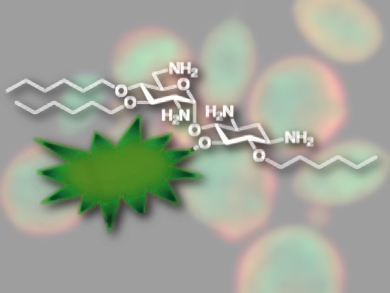Fungal infections have been on the rise because of increasing numbers of people with suppressed or nonfunctional immune systems. One class of synthetic antifungal agents, cationic amphiphiles, have broad-spectrum and potent antifungal activity. How these molecules eradicate fungal cells, however, had not been fully understood so far.
Micha Fridman and colleagues, Tel Aviv University, Israel, have used fluorescent antifungal cationic amphiphiles (pictured) to study the effects of this type of compound on cells of disease-causing fungi. The team treated Candida yeast cells, considered the most common disease-causing fungal pathogen worldwide, with the fluorescent antifungal cationic amphiphiles and then imaged the cells.
The results revealed that the antifungal agents rapidly accumulate inside the cells and lead to changes in the structures of proteins and DNA. The team also discovered that the antifungal compounds disassemble the different intracellular compartments (organelles) inside the fungal cells, which leads to the eradication of the pathogen. According to the researchers, the intracellular effects of these agents must be considered when designing antifungals for clinical use, because they could also affect mammalian cells.
- Cationic Amphiphiles Induce Macromolecule Denaturation and Organelle Decomposition in Pathogenic Yeast,
Micha Fridman, Qais Z. Jaber, Raphael Benhamou, Ido M. Herzog, Bar Ben Baruch,
Angewandte Chemie International Edition 2018.
https://doi.org/10.1002/anie.201809410




